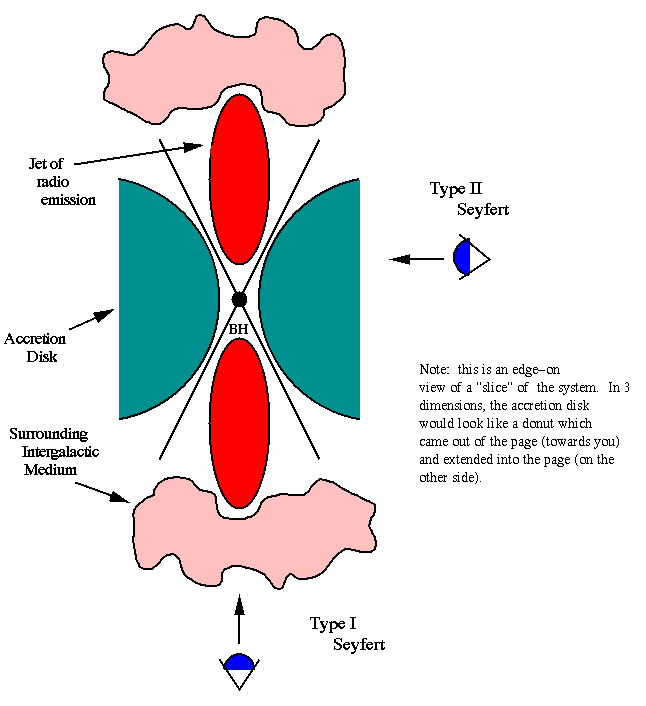
M77 is an archetypical example of a Seyfert type II Galaxy and the brightest galaxy of its class. Galaxies of this type are named after the American astronomer Carl K. Seyfert (1911-1960) who in 1943 first described their characteristics, namely a brilliant starlike nucleus, faint spiral arms, and specific emission line spectra from their nucleus. M77 is a large galaxy and together with its faint outer spiral arms may extend up to 170,000 light years across. As a Seyfert Type II galaxy, it is highly luminous. Although at optical wavelengths the luminosity of Seyferts is not necessarily unusual for spiral galaxies, their total luminosity including radio, x-ray and especially infrared energy is over 100 times that of a normal galaxy. They are believed to be a transitional state between the ultraluminous but remote Quasars and normal galaxies.
Seyfert galaxies are a subclass of galaxies
known as active galaxies. Active galaxies are distinguished from
normal galaxies by virtue of their "active galactic nucleus"
or AGN. Galaxies with an AGN include other subclasses such as
quasars and radio galaxies. Seyfert types have a compact, highly
luminous nucleus which often outshines the remainder of the parent
galaxy. The core luminosity can vary on time scales less than
a year suggesting the energy source is small, probably less than
a single light year.
The Seyfert type nucleus releases prodigious amounts of energy
at a wide range of wavelengths, but is especially strong at infrared
and radio wavelengths. In contrast to a normal galactic nucleus
the energy released from the Seyfert nucleus arises from a nonstellar
source. The central engine of the Seyfert nucleus (and all AGN)
is believed to be an accretion disk that continuously drops matter
into a supermassive black hole.
Overall about 2% of all galaxies are Seyfert types suggesting that Seyferts are either infrequent phenomena, or that normal galaxies go through "active" and "quiescent" periods occasionally transforming into Seyferts for relatively short periods. It is well accepted that most galaxies possess a supermassive black hole in their nucleus however those in normal galaxies are presently quiescent compared to active galaxies. A possible explanation is that accretion disks may be modulated by a feedback mechanism which turns them off after a bright period. If this is true many so called normal galaxies could intermittently enter an "active" phase during their lifetimes.
The Seyfert subtype of active galaxies are further subdivided into two classes, Type I and Type II. Both types have emission line spectra from their nucleus arising from a nonstellar source. Normal galaxies possess only stellar emission lines from old population II stars in the bulge and nucleus however Seyferts display nonstellar emission lines believed to arise from highly excited gas within the nucleus. The emission lines include spectra of iron confirming the process involves gases at very high temperatures. Type I Seyferts have very broad emission lines that arise from gas at high velocity (1000 to 10,000 km/sec). Type II Seyferts have much narrower emission lines presumably from gas traveling at slower velocities of about 100 to 1,000 km/second. Astronomers now believe the difference between Type I and II Seyferts can be explained by the observers viewing angle of the gas jets. Surrounding the accretion disk-black hole complex is a torus shaped (donut shaped) ring of opaque gas. When matter from the rotating accretion disk falls into the black hole, energy is released in the form of super heated gas jets which exit the nucleus at relativistic speeds through the hole in the torus which confines or collimates the jet into a cone shaped structure. In Type I Seyferts the jet is viewed coming at the observer and the high velocity gas is detected directly. The emission lines thus reflect the high energetic state of the gas and are therefore broad. In Type II Seyferts the jet is obscured by the opaque gas of the torus. The gas movement we see is from slower moving clouds further away from the torus. The gas velocities in the Type II Seyferts are therefore slower and their emission lines more narrow.

The above graphic is courtesy of the Astronomy Department, University of Maryland.